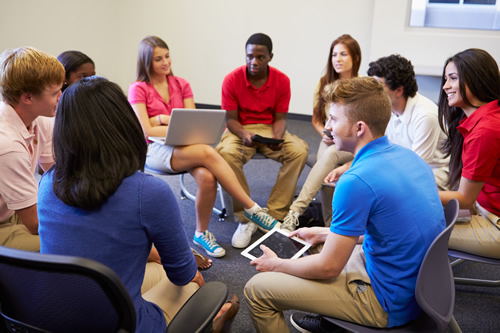As a former social studies educator and current learning specialist, my idea of nirvana is to help grow students who can examine issues from multiple perspectives. Getting them to practice that, however, can be a harrowing experience, particularly when the issues up for discussion are controversial. At Horry County (SC) Schools, we have a diverse student population that is approximately two-thirds white, 20 percent black, and 10 percent Hispanic, and yet we have found a process that combines cooperative learning with a technological tool to help to deepen thinking about topics as sensitive as racism and segregation—and get students looking at issues through multiple perspectives.
Eight years ago, our district began training teachers in cooperative learning as a strategy to maximize student engagement. At the center of cooperative learning is a framework developed by Spencer Kagan called PIES. PIES stands for:
- Positive interdependence: everyone in the group depends on each other for a positive outcome
- Individual accountability: each student is accountable and cannot hide from the learning
- Equal participation: everyone must participate somewhat close to equally
- Simultaneous interaction: the number of students interacting at any one moment in time is increased
Cooperative learning training also embeds methods to develop social skills. Part of what we are teaching kids is to be kind to each other, to be empathetic, and to employ positive social behaviors and language.
Our teachers love the training. When we conduct professional development (PD), we rarely have a teacher who doesn’t give the trainer the highest marks. There are even some who say, “This really saved my career, because I was burned out.”
Group work vs. cooperative learning
When I was still in the classroom, I called lots of activities “group work,” but some students hid from the learning while others carried the group, and that is not true of cooperative learning.
One of the tools we have found to ensure we are practicing cooperative learning is Verso. It’s a structured online discussion platform that fosters positive interdependence while encouraging students to grow in their own thinking because they can read and respond to the thinking of others anonymously. The platform provides individual accountability because everyone is asked to frame a response to a provocation. Not allowing students to see others’ responses before they contribute assures equal participation along with simultaneous interaction. In short, the platform has PIES.
In the years since we adopted cooperative learning, I’ve never seen students who don’t want to read what their peers say, and the anonymous nature of comments in the platform helps to facilitate that eagerness by making students feel safe enough to say what they really think.
You have to provide a safe environment for cooperative learning to work. You have to be committed to instilling the idea that “My first answer is not my best answer. My second answer is better, and my third answer is better yet.”
Addressing controversial topics in diverse classrooms
Early on in our cooperative learning education journey, one of our principals saw cooperative learning in one of our Title I schools. Students were asked to examine the civil rights movement in South Carolina. As we walked into the hallway after class, the principal surprised me when she said, “I think I could do that.”
“Sure you can,” I said. “Let’s go back to the instructional coach’s office and craft a lesson with cooperative learning structures built in.”
Since our students study South Carolina history in grade 8 and this principal was a graduate of South Carolina State University, we decided to encourage these students to take a deep dive into the Orangeburg Massacre, an event in which state highway patrol officers shot and killed three protesters demonstrating against a segregated bowling alley in 1968.
Working with the school’s instructional coach, we created a lesson that culminated with an event in which the students had to take the position of one of the four major groups involved: the National Guard, the protesters, the owner of the bowling alley, or Governor Robert McNair. After writing the positions for the sides they were assigned to, they were asked to make counterarguments to students assigned to different groups.
This wasn’t hypothetical for our students. Some of them have family members who were there. They have a personal connection to these events and strong beliefs about who was right.
The responses from students were incredible, absolutely incredible. In 55 minutes, those students—black and white, the sons and daughters of the people who lived this history—went from a surface understanding built on their own perspectives to deep thinking about the Orangeburg Massacre. They engaged in historical thinking.
PD for cooperative learning
Effective PD is essential in connecting teachers to big ideas and their historical connections. Our state’s academic history standards are largely knowledge and recall, but what’s going to help students retain and recall that knowledge is the deep dives they’ve taken and those explorations that help them see patterns, build personal connections, and, hopefully, see things from another perspective. Those patterns will stay with them longer and those differing personal perspectives will affect them in a more profound way than facts or dates do, while also preparing them to handle disagreements constructively. That’s what we’ve found and why we’re continuing PD in this area. We’re also having great fun along the way.
Our mantra now is, “Not everything in history is worth a deep dive.” I encourage our teachers to pitch the big ideas in history that students will never engage in unless we construct an opportunity for them to do so. I support my teachers in finding events that students aren’t as likely to think deeply about, then having them take an intellectual dive. They might just like the water.
- 5 obstacles AI can help schools overcome - April 16, 2024
- Guidance counselors could help female high schoolers erase the STEM gender gap - April 16, 2024
- How video coaching inspires teacher self-reflection - April 15, 2024

